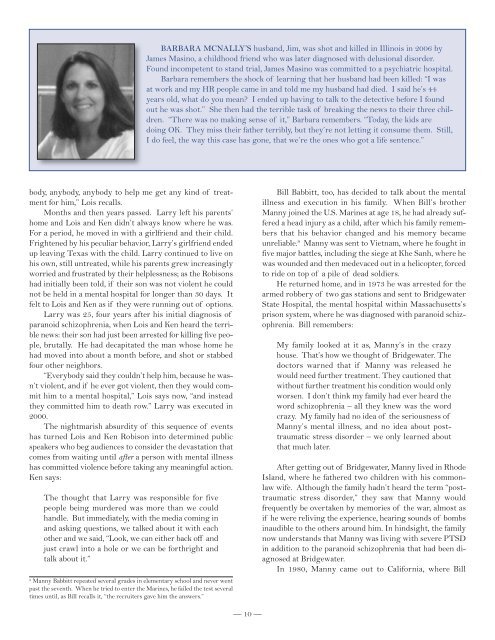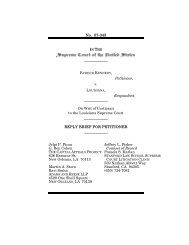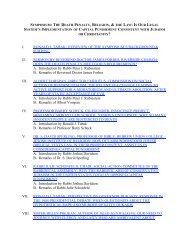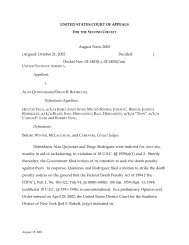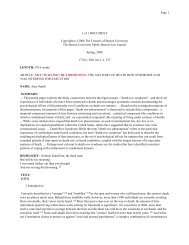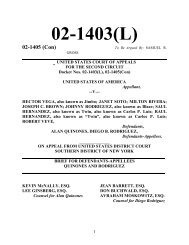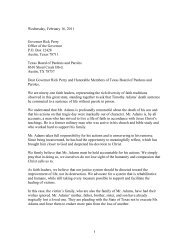Double Tragedies - Families for Human Rights
Double Tragedies - Families for Human Rights
Double Tragedies - Families for Human Rights
- No tags were found...
Create successful ePaper yourself
Turn your PDF publications into a flip-book with our unique Google optimized e-Paper software.
BARBARA MCNALLY’S husband, Jim, was shot and killed in Illinois in 2006 byJames Masino, a childhood friend who was later diagnosed with delusional disorder.Found incompetent to stand trial, James Masino was committed to a psychiatric hospital.Barbara remembers the shock of learning that her husband had been killed: “I wasat work and my HR people came in and told me my husband had died. I said he’s 44years old, what do you mean? I ended up having to talk to the detective be<strong>for</strong>e I foundout he was shot.” She then had the terrible task of breaking the news to their three children.“There was no making sense of it,” Barbara remembers. “Today, the kids aredoing OK. They miss their father terribly, but they’re not letting it consume them. Still,I do feel, the way this case has gone, that we’re the ones who got a life sentence.”body, anybody, anybody to help me get any kind of treatment<strong>for</strong> him,” Lois recalls.Months and then years passed. Larry left his parents’home and Lois and Ken didn’t always know where he was.For a period, he moved in with a girlfriend and their child.Frightened by his peculiar behavior, Larry’s girlfriend endedup leaving Texas with the child. Larry continued to live onhis own, still untreated, while his parents grew increasinglyworried and frustrated by their helplessness; as the Robisonshad initially been told, if their son was not violent he couldnot be held in a mental hospital <strong>for</strong> longer than 30 days. Itfelt to Lois and Ken as if they were running out of options.Larry was 25, four years after his initial diagnosis ofparanoid schizophrenia, when Lois and Ken heard the terriblenews: their son had just been arrested <strong>for</strong> killing five people,brutally. He had decapitated the man whose home hehad moved into about a month be<strong>for</strong>e, and shot or stabbedfour other neighbors.“Everybody said they couldn’t help him, because he wasn’tviolent, and if he ever got violent, then they would commithim to a mental hospital,” Lois says now, “and insteadthey committed him to death row.” Larry was executed in2000.The nightmarish absurdity of this sequence of eventshas turned Lois and Ken Robison into determined publicspeakers who beg audiences to consider the devastation thatcomes from waiting until after a person with mental illnesshas committed violence be<strong>for</strong>e taking any meaningful action.Ken says:The thought that Larry was responsible <strong>for</strong> fivepeople being murdered was more than we couldhandle. But immediately, with the media coming inand asking questions, we talked about it with eachother and we said, “Look, we can either back off andjust crawl into a hole or we can be <strong>for</strong>thright andtalk about it.”9Manny Babbitt repeated several grades in elementary school and never wentpast the seventh. When he tried to enter the Marines, he failed the test severaltimes until, as Bill recalls it, “the recruiters gave him the answers.”Bill Babbitt, too, has decided to talk about the mentalillness and execution in his family. When Bill’s brotherManny joined the U.S. Marines at age 18, he had already suffereda head injury as a child, after which his family remembersthat his behavior changed and his memory becameunreliable. 9 Manny was sent to Vietnam, where he fought infive major battles, including the siege at Khe Sanh, where hewas wounded and then medevaced out in a helicopter, <strong>for</strong>cedto ride on top of a pile of dead soldiers.He returned home, and in 1973 he was arrested <strong>for</strong> thearmed robbery of two gas stations and sent to BridgewaterState Hospital, the mental hospital within Massachusetts’sprison system, where he was diagnosed with paranoid schizophrenia.Bill remembers:My family looked at it as, Manny’s in the crazyhouse. That’s how we thought of Bridgewater. Thedoctors warned that if Manny was released hewould need further treatment. They cautioned thatwithout further treatment his condition would onlyworsen. I don’t think my family had ever heard theword schizophrenia – all they knew was the wordcrazy. My family had no idea of the seriousness ofManny’s mental illness, and no idea about posttraumaticstress disorder – we only learned aboutthat much later.After getting out of Bridgewater, Manny lived in RhodeIsland, where he fathered two children with his commonlawwife. Although the family hadn’t heard the term “posttraumaticstress disorder,” they saw that Manny wouldfrequently be overtaken by memories of the war, almost asif he were reliving the experience, hearing sounds of bombsinaudible to the others around him. In hindsight, the familynow understands that Manny was living with severe PTSDin addition to the paranoid schizophrenia that had been diagnosedat Bridgewater.In 1980, Manny came out to Cali<strong>for</strong>nia, where Bill__ 10 __


